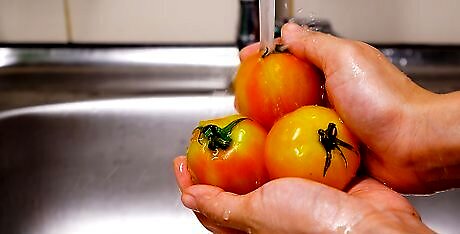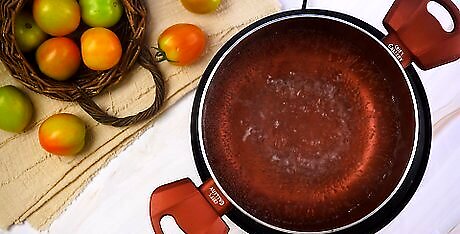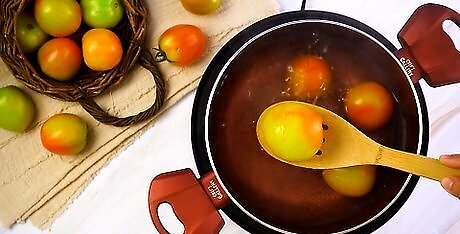
views
Prep time: 10-20 minutes
Cook time: 1 minute
Total time: 10-20 minutes
Getting Your Tomatoes Ready

Wash the tomatoes under cold water. Gently run the tomatoes under cold tap water to remove any dirt or debris before you cook them. Slowly turn each tomato under the tap so that its entire surface is exposed to water. Only use firm tomatoes that are glossy and deep red. Remove any tomatoes that have soft or rotten spots as you clean them.

Trim the stems using a small knife. Insert the top 1 centimetre (0.39 in) of your knife into each tomato, with your thumb on the tomato and your remaining four fingers on the dull edge of the blade. Hold the bottom of the tomato with your free hand and cut in a circular direction around the stem. If you're using a stem remover, insert the serrated teeth into the tomato and twist it around until it's as far as it can go. Afterwards, pull the tool directly out to remove the stem.

Cut a 1 inch (2.5 cm) "x" into the bottom of each tomato. Hold a small, sharp knife above the tomato and gently drag it along the bottom. Cut the "x" deep enough to pierce the skin without going too much into the flesh. Creating an "x" will allow the heat from the boiling water to enter the tomato and loosen the skin, making it very easy to peel. Each line should be about 1 inch (2.5 cm) long.
Boiling Your Tomatoes

Boil a large pot of water. Use a pot large enough to hold all your tomatoes and fill it about 3/4 of the way full. You should have enough water to fully submerge all of your tomatoes. Add 12 tablespoons of salt per 1 gallon (3.8 L) of water and then bring it to a rolling boil, which is when the water doesn't stop boiling when stirred. Salt is not necessary, but it increases the boiling point of water. This helps it come to a more steady boil than unsalted water.

Prepare an ice water bath. Fill a large bowl with water and ice. Set this bowl aside for now—it will be used to prevent the tomatoes from cooking too much after you boil them. Extended cooking can cause the tomatoes to get mushy. If you're blanching more than a dozen tomatoes, create another ice water bath. About 1 per dozen should be fine.

Submerge the tomatoes in the boiling water for 30 to 60 seconds. Don't submerge more than a dozen tomatoes at a time, as they will become too hard to manage. You'll know the tomato is ready when its skin starts to peel back. Smaller tomatoes might cook as quickly as 30 seconds. The time varies depending on tomato size. Don't cook your tomatoes for too long – this can cause the flesh to get grainy and mushy.
Peeling and Storing Your Tomatoes

Remove the tomatoes with a slotted spoon 1 at a time. Gently remove each tomato from the water. Hold each tomato over a sink or empty bowl to minimize the amount of boiling water you bring with you. Turn off the element heat before removing the tomatoes.

Plunge the tomatoes in the ice water for 30 seconds to 1 minute. Afterwards, remove them using your hands and place them on a cutting board. Use a clean rag to gently dry them off. Turn each tomato around with your hand to make sure its entire surface is exposed to the ice water.

Peel away the skin starting from your "x" immediately after drying. If the tomatoes have been cooked and cooled properly, the skin should peel off with little trouble using your hands. Use a sharp knife for tough spots by gently sliding it under the tomato skin and lifting. Work slowly and take care not to cut the tomato flesh.

Place your skinned tomatoes onto cookie sheets and put them in the freezer. Check on them after 1 hour—if they're not completely frozen, leave them in for another hour. Gently squeeze each tomato when you check on them—if there are any soft spots, they need more time in the freezer.

Transfer your frozen tomatoes into freezer bags. Seal each bag as tightly as possible to minimize the air inside and reduce spoilage. Afterwards, put them back in the freezer for a maximum of 8 months. When using frozen tomatoes, you can remove them one at a time or all at once. Signs of bad tomatoes include mold, discoloration, and a rancid odor.



















Comments
0 comment